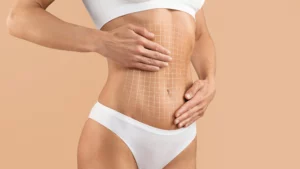Gynecomastia, the development of enlarged male breast tissue, is a common concern for men on testosterone therapy. The way to prevent gynecomastia while on testosterone is to ensure precise hormone dosing, regularly monitor your hormone levels, consider using estrogen blockers if recommended by your provider, and maintain a healthy lifestyle that supports balanced hormones.
Below, we’ll explore the science behind gynecomastia, why it can develop during testosterone therapy, prevention strategies, and what to do if you notice symptoms. You’ll also discover how Dr. Venkata Erella at Aspira Plastic Surgery can help you achieve your aesthetic goals.
What Is Gynecomastia?
Gynecomastia refers to the benign enlargement of male breast glandular tissue. Unlike fat accumulation (pseudogynecomastia), true gynecomastia is caused by an imbalance of hormones, specifically, an increase in estrogen relative to testosterone. This hormonal shift stimulates breast tissue growth, often resulting in swelling, tenderness, and changes in the chest contour.
—
Understanding Testosterone Therapy and Its Impact on Gynecomastia
Testosterone therapy, or testosterone replacement therapy (TRT), is prescribed to men with low testosterone levels to restore hormonal balance, improve vitality, and support overall health. However, testosterone can convert into estrogen through a process called aromatization. If estrogen levels become elevated, gynecomastia may develop, even in men on TRT. Therefore, understanding how to prevent gynecomastia while on testosterone is crucial for anyone undergoing or considering hormone therapy.
—
Role of Testosterone in Male Physiology
Testosterone is the primary male sex hormone, responsible for muscle mass, bone density, libido, and male secondary sexual characteristics. It also plays a key role in suppressing breast tissue growth. Any disruption in testosterone levels, especially when estrogen levels are relatively high, can trigger gynecomastia.
—
What Causes Gynecomastia?
Gynecomastia can arise from various factors, both hormonal and non-hormonal. Let’s break down the most common causes and how they relate to testosterone balance.
Common Causes of Gynecomastia
- Puberty: Hormonal fluctuations during puberty often cause temporary gynecomastia, which usually resolves on its own.
- Medications: Certain drugs, including anti-androgens, anabolic steroids, some antidepressants, and chemotherapy agents, can interfere with hormone balance, leading to breast tissue growth.
- Substance Use: Alcohol, marijuana, and some illicit drugs can promote estrogen production or inhibit testosterone, contributing to gynecomastia.
- Aging: As men age, testosterone levels naturally decline, while body fat and estrogen production may increase.
- Obesity: Fat tissue contains aromatase, an enzyme that converts testosterone to estrogen. Higher levels of body fat can thus promote gynecomastia.
- Genetics: Some men inherit a predisposition to hormonal imbalances that can lead to gynecomastia.
Testosterone and Estrogen Balance
Testosterone and estrogen exist in a delicate balance. When men undergo testosterone therapy, the body may compensate by converting excess testosterone into estrogen. This is especially true with high doses or improper administration. Therefore, understanding how to prevent gynecomastia while on testosterone involves managing this hormonal interplay.
Can Low Testosterone Cause Gynecomastia?
Yes. Low testosterone means less suppression of breast tissue growth and can tip the balance in favor of estrogen, leading to gynecomastia—independent of, or in conjunction with, testosterone therapy.
What Causes Gynecomastia in Bodybuilders?
Bodybuilders are particularly susceptible due to the use of anabolic steroids, which can suppress natural testosterone production and increase estrogen through aromatization. This hormonal shift is a leading cause of gynecomastia in this population.
—
Symptoms and Diagnosis of Breast Enlargement
Gynecomastia typically presents as a rubbery or firm mass extending concentrically from the nipples. It may be tender or sensitive, and in some cases, emotional distress or self-consciousness can occur due to the change in chest appearance.
Symptoms of Gynecomastia:
- Swelling of the breast gland tissue
- Breast tenderness
- Firmness under the nipple area
- Bilateral or unilateral enlargement
- Emotional discomfort
Gynecomastia is relatively common among bodybuilders, especially those who use anabolic steroids or other performance-enhancing drugs. Estimates suggest up to 50% of steroid-using athletes experience some degree of gynecomastia during their careers. As testosterone levels rise, the aromatase enzyme may convert excess testosterone into estrogen, stimulating breast tissue growth. This potential side effect underscores the importance of understanding how to prevent gynecomastia while on testosterone.
Treatment strategies may differ for men on testosterone therapy. In addition to standard approaches, it’s often necessary to address the underlying hormonal imbalance, possibly adding aromatase inhibitors or adjusting the TRT regimen.
—
How to Prevent Gynecomastia While on Testosterone
Preventing gynecomastia during testosterone therapy is a multi-faceted approach involving medical, lifestyle, and sometimes pharmacologic strategies.
Precise Testosterone Dosing and Delivery
- Work with an experienced provider who can determine your body’s optimal dose and delivery method.
- Avoid excessive dosing, which increases estrogen conversion.
- Regularly monitor blood hormone levels (testosterone, estradiol, and others).
Estrogen Blockers
Not everyone requires an estrogen blocker, but some men benefit from medications that limit the conversion of testosterone to estrogen (aromatase inhibitors). This decision should be made in collaboration with your provider, based on your hormone levels and symptoms. Arimidex (anastrozole) is an aromatase inhibitor sometimes prescribed to prevent estrogen-related side effects, including gynecomastia, during testosterone therapy. Its use must be carefully tailored to individual needs, as overuse can suppress necessary estrogen levels and cause other side effects.
Lifestyle and Fitness Considerations
- Maintain a healthy body weight: Lower body fat reduces aromatase activity and estrogen production.
- Limit alcohol and avoid recreational drugs: Both can elevate estrogen.
- Eat a balanced diet: Focus on lean proteins, vegetables, and healthy fats.
- Manage stress: High cortisol can negatively affect hormone balance and weight.
While exercise can’t directly target glandular breast tissue, building chest muscle and reducing overall body fat can improve chest contour and decrease the prominence of gynecomastia.
- Resistance training: Focus on pectoral exercises (bench press, push-ups, chest fly).
- Cardiovascular exercise: Supports fat loss and overall hormone health.
No supplement can guarantee prevention or reversal of gynecomastia, but some may support healthy testosterone levels, including zinc, vitamin D, and magnesium. Always consult your provider before starting supplements, as interactions and efficacy vary.
Natural Ways to Support Testosterone
- Exercise regularly, especially with strength training.
- Prioritize sleep — 7–9 hours per night.
- Eat a balanced diet, including healthy fats, proteins, and vegetables.
- Maintain a healthy weight.
- Manage stress through meditation and other relaxation techniques.
- Limit alcohol consumption.
- Avoid exposure to endocrine disruptors (certain plastics, chemicals).
- Get regular sunlight or consider vitamin D supplementation.
- Ensure adequate zinc and magnesium intake.
- Stay sexually active (within reason), as this can support natural testosterone production.
—
Treatment Options for Gynecomastia
Treatment depends on the underlying cause and severity. In cases where the condition is persistent or causes significant distress, surgical intervention may be the most effective solution.
- Observation: Sometimes gynecomastia resolves on its own, especially during puberty.
- Medication adjustment: If caused by drugs, stopping or switching medications may help.
- Hormonal therapy: Aromatase inhibitors or selective estrogen receptor modulators may be prescribed.
- Surgery: Removal of glandular tissue and/or liposuction for persistent or severe cases.
For more on surgical options, see our male body contouring page.
Alternative therapies, including herbal remedies and over-the-counter products, lack strong scientific support. It’s essential to approach these cautiously and consult a medical professional before use.
Exercise can help reduce fat and improve the appearance of the chest, but it cannot eliminate glandular breast tissue. True gynecomastia often requires medical or surgical intervention for complete resolution.
In some cases, such as puberty or temporary medication-induced gynecomastia, the condition may resolve without intervention. However, persistent gynecomastia, especially in adults, is less likely to disappear spontaneously.
—
Is Testosterone Therapy Right for You?
TRT can improve energy, mood, libido, muscle mass, bone density, and overall quality of life in men with clinically low testosterone. However, therapy should be carefully managed to minimize side effects like gynecomastia.
A thorough evaluation by a qualified provider is essential. Discuss your medical history, symptoms, and goals with an expert if you’re considering TRT. Explore our FAQs or schedule a consultation with Dr. Erella for comprehensive information.
—
Aspira Plastic Surgery Can Help With Gynecomastia Treatment
At Aspira Plastic Surgery, Dr. Erella provides advanced gynecomastia evaluation and treatment tailored to your unique needs. Whether you’re seeking prevention advice, medical management, or surgical correction, Dr. Erella’s expertise ensures you receive personalized care in a supportive environment. Discover our philosophy and approach on the About Us page, and read real patient experiences in our patient reviews.
—
The Bottom Line
Gynecomastia is a manageable concern for men on testosterone therapy. If you have such problems, consult Dr. Erella at Aspira Plastic Surgery for trusted support and proven solutions.
—
FAQs About Gynecomastia During Testosterone Therapy
1. What is the difference between gynecomastia and excess breast tissue caused by fat?
Excess breast tissue from gynecomastia involves glandular growth, while fat-related chest fullness is due to excess fatty tissue.
2. How can I tell if I have male breast enlargement or just weight gain?
Male breast enlargement typically feels firmer and more centralized under the nipple compared to generalized fat accumulation.
3. What does enlarged breast tissue feel like in men?
Enlarged breast tissue usually presents as a rubbery, firm mass beneath the nipple and may be sensitive to touch.
4. Does excess fatty tissue in the chest always mean gynecomastia?
No, excess fatty tissue can occur without glandular changes and doesn’t necessarily indicate you’re developing gynecomastia.
5. Can gynecomastia lead to breast cancer in men?
Gynecomastia itself doesn’t cause cancer, but men should still be aware of potential signs of breast cancer and consult a doctor if concerned.
6. Why does TRT sometimes cause chest changes?
Undergoing testosterone replacement therapy can raise estrogen through aromatization, potentially triggering unwanted breast tissue enlargement.
7. What are the best ways to treat gynecomastia?
To effectively treat gynecomastia, your provider may suggest hormonal medications, lifestyle changes, or male breast reduction surgery.
8. Is breast tissue enlargement common during hormone therapy?
Yes, breast tissue enlargement can occur if estrogen levels rise relative to testosterone, especially without regular hormone monitoring.
9. How rare is male breast cancer, and should I worry?
Male breast cancer is rare but possible, so a medical professional should evaluate any unusual lumps or nipple discharge.
10. How can I maintain balanced hormone levels naturally?
Eating a nutrient-rich diet, getting enough sleep, managing stress, and exercising regularly help maintain balanced hormone levels.
11. Is combining testosterone treatments with other hormone-modulating drugs safe?
Combining testosterone treatments with anti-estrogens or steroids should only be done under close medical supervision to avoid complications.
12. How do I monitor for abnormal breast growth while on TRT?
Watch for signs of breast growth, such as firmness, tenderness, or a visible increase in breast size, and report them to your provider.
13. What can I do to prevent male breast tissue from developing?
To prevent male breast tissue growth, ensure your testosterone dosage is managed correctly and consider estrogen monitoring if needed.
14. When is male breast reduction the best option?
Male breast reduction is often recommended when gynecomastia does not respond to medications or lifestyle modifications.
15. Can hormone imbalance affect muscle growth and breast appearance?
Yes, a hormone imbalance can hinder muscle growth and increase the risk of developing enlarged breast tissue.










